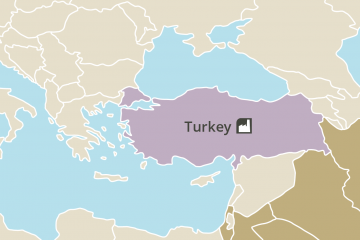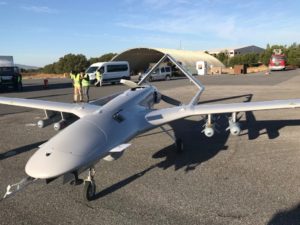
Turkey
Turkey’s interest in armed drones emerged in 2008, when they sought permission to purchase the MQ-1 Predator from the US, and instead were offered the non-armed version of the Reapers. After refusing the US offer, Turkey purchased unarmed Heron TPs from Israel in 2010, and has since taken an ambitious approach to domestic production of armed UAVs.
Ankara is rapidly expanding its fleet of armed and domestically produced UAVs, having developed two main types for series production – the Anka-S and Bayraktar TB2 – and with a third, the Karayel, thought to be in the prototyping and testing phase. The TB2, which have been in the inventory of the Turkish armed forces, the gendarmerie and the police since 2014, currently makes up the majority of the Turkish air force fleet, with almost 50 already delivered.[1] The larger and more capable Anka-S, on the other hand, which was envisioned in the early 2000s for tactical surveillance and reconnaissance missions only, has been operational since 2013, but only in relatively small numbers.[2]
NOTES
[1] Author interviews with Turkish UAV experts, Istanbul, 13–14 September 2018.
[2] Ibid.
Armed UAV inventory

Drone
Anka-S UAV
Type
Medium Altitude, Long Endurance (MALE) UAV
Manufacturer
Turkish Aerospace Industries (TAI)
Number
Est. 6
Endurance
Up to 24 hours depending on payload
Loaded Weight
1,600kg
Payload Capacity
200kg
Range
>1,000km (SatCom and ground control station modes)
Sensor Options
EO/forward-looking infrared/laser range finder payload option and SAR/GMTI/ inverse SAR payload option
Weaponry
Likely capacity of at least four Roketsan MAM-L/MAM-C missiles

Drone
Bayraktar TB2 UAV
Type
Tactical UAV
Manufacturer
Kale-Baykar
Number
46
Endurance
Up to 24 hours depending on payload
Loaded Weight
650kg
Payload Capacity
55kg
Range
150km (limited by control range from ground control station)
Sensor Options
IR and EO camera, laser designator, laser range finder (LRF)
Weaponry
Up to four Roketsan MAM-L/MAM-C missiles

Drone
Vestel Karayel-SU UAV
Type
Tactical UAV
Manufacturer
Vestel Defence Industry
Number
Est. 2
Endurance
Up to 20 hours depending on payload
Loaded Weight
550kg
Payload Capacity
70kg
Range
around 150km (limited by control range from ground control station)
Sensor Options
IR and EO, laser designator, LRF
Weaponry
Up to two Roketsan MAM-L and/or four Roketsan MAM-C missiles
Turkey perceives drones as a matter of domestic pride and a ‘game-changer’ weapon.[1] Once its allies had rejected requests to provide Ankara with drones or attached conditions by which they could not be used within Turkey, the country started to produce domestically to send a political signal and reduce external dependency, while at the same time jumping ahead of the curve in the field of autonomous systems.[2] While they were perceived as providing additional capabilities compared to manned aircraft since the beginning of their introduction into service, recently their use appears to have changed Turkey’s airpower norms and behaviours.
Armed UAVs have been pioneered by the private sector rather than the military in Turkey. The normal bureaucratic process involving the tender, development and procurement structure is usually bypassed when armed UAVs are involved, with direct industry engagement with the president and the highest-level decision-makers.[3] The first operational type of drones – the Bayraktar TB2 – is an armed UAV which does not have satellite link or other beyond-line-of-sight control capabilities, and as such is limited to operations within around 150km of its ground station. It entered service in 2016 and was soon taking part in strike operations against the Kurdistan Workers’ Party (PKK) separatist movement inside Turkey and across the border in Kurdish areas in neighbouring Syria, despite the threat of Daesh being commonly cited in Turkey as a key driver behind the rush to develop armed drones.
The same pattern was repeated with the larger and more capable Anka-S in 2017, which was reportedly being used for strikes even before it had officially entered service.[4] Engineers from TAI and Kale-Baykar also regularly deploy with operational units to provide support and ensure that design changes required as a result of combat experience are quickly incorporated in later models. This pattern of close cooperation between the military and defence industry to combat-test new UAVs before the design is finalised is also common in Israel.
The Anka-S bears an external resemblance to the Israeli Hermes 900 and has been designed to be controllable by satellite link to extend its operational range to well beyond 1,000km. It is also interesting to note that both the Anka-S and Bayraktar TB2 employ domestically designed Turkish PGMs, rather than relying on Israeli, Chinese or American imports. Turkey’s drone programme may lack some of the sophistication of its US and Israeli counterparts at present, but it is evidence of how fast a modern state can develop functional armed UAVs and an industry to produce them if the political willpower and funding is behind the effort.
The government in Ankara plans to build at least 100 armed UAVs for surveillance and strikes against the Kurds inside and outside Turkey, with a secondary role as border surveillance and counterterrorist assets in the wider region in uncontested airspace.[5] For a population largely inured to large-scale airstrikes by fast jets against the PKK within Turkey, as well as to regular acts of terrorism by the PKK and other groups, the use of armed UAVs is unlikely to raise significant political concerns or even excite much comment beyond pride in Turkish industry’s success in producing them.[6]
In terms of command arrangements, the divide between political actors, intelligence and law enforcement agencies and the military is somewhat blurred since the crackdown and purges following the attempted coup in 2016. Nonetheless, as a rule the larger, the SatCom-controlled Anka-S is under the command of the Turkish air force while the Bayraktar TB2 is a tactical asset under army and agency ownership.[7] Both are large enough and fly at sufficient altitude to require integration with the standard recognised air picture during operations, which falls under air force control. Internal security forces also have their own UAV units.
Both the Turkish air force and army employ armed UAVs in much the same way as fast jets and rotary-wing gunships in strikes on militants and in support of friendly forces. For the army, the Bayraktar TB2 is now widespread and considered one of the primary strike platforms for tactical operations. A notable difference is the lower escalation risk and risk to life from using UAVs instead of fast jets in the contested skies over Syria, meaning that the Bayraktar TB2, and especially the Anka-S, are increasingly the tool of choice for the Turkish air force in
cross-border operations, such as Operation Olive Branch in Afrin during early January 2018, where they were reportedly highly effective.[8] Furthermore, as the presence of advanced MANPADS in Kurdish- and Daesh-held areas has increased, the traditional role of attack helicopters has diminished in favour of less vulnerable and more expendable armed UAVs.
In terms of rules of engagement, the geographical limitation is only dictated by the type of operations, meaning that there is no limit in targeting Turkish or foreign citizens, if they are designated as terrorists. Drones are also regularly used for positive identification of targets for indirect fire during conventional combat operations. Civilian casualties, albeit not a primary concern of Turkey, have been reduced through the integration of UAV surveillance with artillery systems.[9]
Although most of the strikes in Afrin were carried out in support of advancing friendly ground forces in much the same way they would have been by more traditional fast jets, a dual strike on 15 August 2018 in Sinjar, Iraq tells a different story. Here, Turkish UAVs were used to assassinate a prominent leader of the Sinjar Resistance Units (Yekîneyên Berxwedana Şengalê, or YBS) and the PKK, İsmail Özden. The strike involved an initial precision attack on Özden’s vehicle and a subsequent strike on a second vehicle which had retrieved casualties from the first. The incident was much celebrated in the Turkish media, and the apparent public support for this extra-national, extra-judicial killing using armed UAVs is likely to encourage the authorities in Ankara to conduct more operations along similar lines, especially given the recent posture towards conducting more surgical operations to respond to what is perceived in Ankara as asymmetrical warfare.[10]
While previous operations would have placed Turkey in the category of countries whose employment of airpower had not been changed by the acquisition of armed UAVs, the Sinjar strike is a significant departure from previous operational norms. Turkey would not have conducted a strike so far into Iraqi territory with manned combat aircraft.
NOTES
[1] Can Kasapoğlu and Barış Kırdemir, ‘The Rising Drone Power: Turkey on the Eve of its Military Breakthrough’, Centre for Economics and Foreign Policy Studies, June 2018, <http://edam.org.tr/en/the-rising-drone-power-turkey-on-the-eve-of-its-military-breakthrough/>, accessed 20 August 2018.
[2] Author interview with Turkish defence expert, Berlin, 19 August 2018. Turkey believes it needs to catch up with what was domestically perceived as a broader industrial revolution in the region, which the country missed.
[3] Author interview with Turkish defence expert, Berlin, 19 August 2018. It is interesting to note that the son-in-law of Turkish President Recep Tayyip Erdoğan is head of the company that provides armed drones to the Turkish army.
[4] Joanna Frew, ‘Drone Wars: The Next Generation’, Drone Wars UK, May 2018, p. 15.
[5] Author interviews with Turkish UAV experts, Istanbul, 13–14 September 2018.
[6] Ibid.
[7] Ibid.
[8] Ibid., Operation Olive Branch was a Turkish military offensive against Kurdish forces in northern Syria, successfully conducted between January and March 2018.
[9] Author interview with Turkish defence expert, Berlin, 19 August 2018.
[10] Author interviews with Turkish UAV experts, Istanbul, 13–14 September 2018; Burak Ege Bekdil, ‘Unmanned Tech Ambitions Shape Turkey’s Future Military’, Defense News, 6 March 2018.